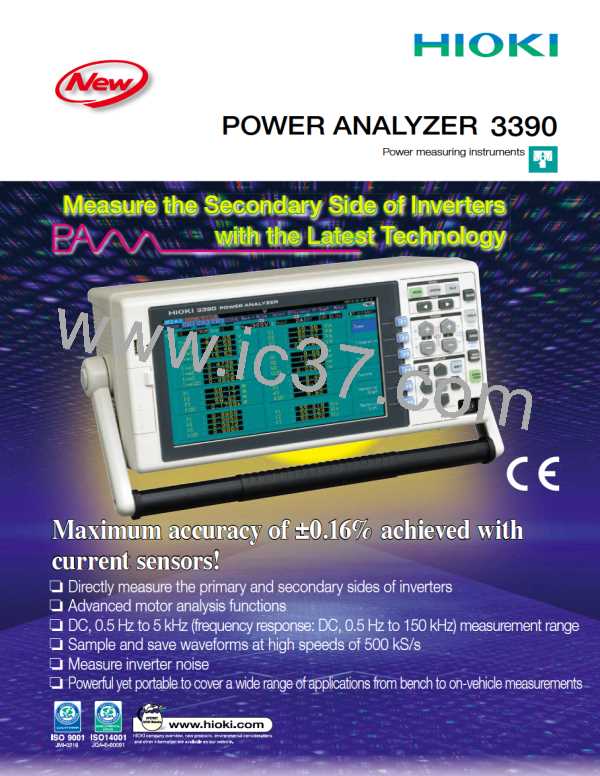8
Geared for the latest motor evaluation and analysis of Hybrid Electric Vehicles, Electric Vehicles and the like
Drive the research and development of three-phase inverter motors with high accuracy and high-speed measurements
Advantages
1. Use of the MOTOR TESTING OPTION 9791 (9793) lets you perform a total evaluation of inverter motors
2. The voltage, torque, rotation, frequency, slip, and motor power required for motor analysis can be measured with one unit
3. Current sensors make the connection simple. In addition, use of the AC/DC CURRENT SENSOR 9709 enables measurements with superior accuracy
Proprietary HIOKI Technology
4. All data is measured simultaneously and updated every 50 ms. Data collection and characteristics tests can be performed at the industry’s fastest speed
5. Evolution of electrical angle measurements critical to motor analysis has made it possible to perform more accurate measurements using an
incremental encoder
6. Harmonic analysis at 0.5 Hz to 5 kHz without the need for an external timing mechanism
7. Built-in digital anti-aliasing filter (AAF) lets you measure the broadband power on the secondary side of inverters to make accurate harmonic
analyses
● Example of HEV and EV measurement systems
Inverter
Torque sensor Encoder
Battery
Motor
Load
Measure the primary side of inverters
Measure the secondary side of inverters and of motor outputs
(Using channels 1, 2, and 3, and the Motor Testing Option)
(Using 4 channels)
Voltage, current, power, power factor,
±electrical energy, frequency, harmonic
analysis *1, noise measurement
Voltage, current, power, power factor, ±electrical energy,
inverter loss, efficiency *1, harmonic analysis *2, noise
measurement, rotation, torque, slip, and motor power
Torque sensor
• Torque
• Rotation
+
*1: Harmonic components superimposed on the DC
can be analyzed by synchronizing to the secondary
side
*1: Between the primary and secondary sides, between the secondary side
and motor output, and between the primary side and motor output
*2: If the fundamental frequency varies between the primary and secondary
sides, the harmonic analysis can be performed for only one side
9791 (9793)
Encoder A-phase signal
Evaluate high-performance vector control inverters:
1
• Measurements of fundamental wave voltage and current and their phases based on an accurate
harmonic analysis are indispensable to motor analysis
Encoder Z-phase signal
• Support of an incremental encoder allows detecting synchronization signals from a motor easily
and accurately
θ
Voltage / current waveform
Electrical angle measurements are indispensable for dynamic characteristics analysis of motors.
The 3390 can conduct FFT analyses synchronized to rotation pulses from the tachometer and the motor
induced voltage, and the A-phase and Z-phase pulse inputs that allow measuring and detecting the origin
of the motor more simply and accurately – fully meeting the needs of the latest motor analysis tests.
Application 1: “Electrical angle measurement”
■
Example of sensor connection
○ The voltage / current fundamental wave component “θ” from the machine angle origin can be
calculated by performing harmonic analysis of motor input voltage / current by synchronizing to the
A-phase signal and z-phase signal of an encoder.
Torque meter
Torque value / frequency output
Incremental type rotary encoder
A-phase pulse output
○ A function to perform zero compensation for this phase angle when a motor induced voltage is
generated can be used to measure the voltage and current phase (electrical angle) in real time based
on the induced voltage when the motor is started.
Z-phase pulse output
speed can be controlled by changing the speed of the rotating magnetic field (power supply frequency).
In addition, high operating efficiency is one of the advantages of the synchronous motor.
■
The importance of measuring the electrical angle of synchronous motors
The key to the performance of high-performance low-fuel consumption vehicles represented
by HEV and EV is the synchronous motor that is used as the power source. The synchronous
motor is finely controlled by alternating signals generated by an inverter device (DC to AC
conversion) using the electricity from batteries.
● Why is electrical angle measurement necessary?
In the case of a synchronous motor, a phase shifting occurs between the stator magnetic pole and
the rotator magnetic pole due to a change in the load torque. This shifted angle and the torque
force that can be generated by a motor have a close relationship, so it is important to understand
this shifted angle (electrical angle) in order to achieve high-efficiency motor control.
● What is a synchronous motor?
A synchronous motor rotates in synchronization with the AC frequency. Structurally, the motor is turned
by the rotating force at the magnetic pole of the rotator (rotator magnetic pole), which is generated by
the rotating magnetic field generated by applying an alternating current to the magnetic field (stator
magnetic pole). The rotation speed is synchronized to the speed of the rotating magnetic field, so the
● The 3390 provides a more accurate measurement method
The 3390 supports the incremental encoder output in addition to the measurement methods of the HIOKI
3194 Power HiTESTER – enabling you to measure this electrical angle more easily and accurately.

 ASM-SENSOR [ ASM GMBH ]
ASM-SENSOR [ ASM GMBH ]